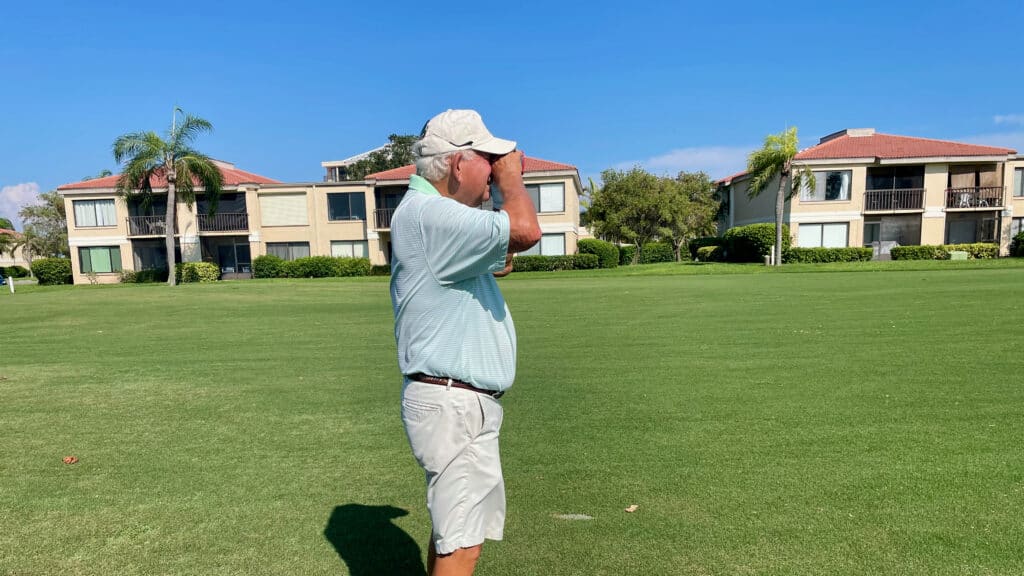Table of Contents
Are you a seasoned golfer over 50 seeking to sharpen your skills and stay competitive amongst younger players? Look no further for valuable golf course management tips.
With a wealth of experience under your belt, you have the strategic advantage to excel over younger golfers. Whether you’re participating in challenging golf tournaments or enjoying a casual round, understanding and applying effective golf course management tips can significantly enhance your performance and enjoyment on the course.
You may have heard the phrase, “the shortest distance between two points is a straight line,” this directly applies to your golf course management strategy. In this article, I will share personal experiences and offer a structured approach designed to enhance your golf course management strategies.
When I decided to take golf seriously in 2007, I needed to pass a 36-hole Playing Ability Test (PAT) to gain access into becoming a member of the PGA of America. At that time, I held a 1.2 handicap index, but I never played a competitive 36-hole tournament in one day. Fortunately, I had several years of experience playing in amateur events that helped me overcome many challenges.
The mental aspect of tournament play can be a unique challenge. We will also cover the top mental techniques used by competitive golfers. From coping with bad weather to managing slow play, every challenge is an opportunity to apply and refine your strategy.
From bad weather to slow play, ALL my senses were being tested. Looking back on that fateful day, here are the top 5 golf course management strategy tips that I used:
Quick Summary: Golf Course Management Tips
- Know the Course Yardage.
- Evaluate the Shape of the Hole.
- Play Smarter: Know the Golf Course Conditions.
- Putting Surface: Understanding the Greens.
- Seek Local Course Knowledge.
In the following sections, I’ll break down each of these tips, providing real-life examples of how they’ve enhanced my golf game and how they can improve yours as well.
⛳️ Related: Out Play Your Competition with Your Mental Game
1. Know the Golf Course Yardage

When facing challenges in scoring on the golf course, a key strategy to reduce strokes is to know the hole’s exact distance before you swing. This knowledge allows you to craft a strategic plan of attack for each shot.
Take a 325-yard Par 4, for instance. If it’s surrounded by hazards, a prudent choice might be to use a 5 iron off the tee, then a pitching wedge for the approach. Conversely, if the hole is wide open, you might opt for a driver to get closer to the green. Understanding each hole’s specific yardage guides your decision-making for approach shots.
I can’t recall the number of times that I left myself with an awkward distance for my approach shot simply because I elected to hit my driver as far as I could. There is no worse feeling than hitting a perfect drive and following it up with a poor approach shot. Or another example, when you hit your drive into a tough lie and struggle with getting your next shot close to the hole.
Pro Tip: Understanding the yardage of the total course is helpful but breaking down hazard or layup areas can present a more desired birdie putt.
For example, on a short Par 5 with water hazards and out-of-bounds stakes near the green, a strategic sequence of driver, mid-iron, and wedge can be more effective. Playing with such strategies can significantly level the playing field.
⛳️ Related Article: Best Golf Rangefinders for the Money
2. Evaluate the Shape of the Hole

Course maps or booklets are easy to read for the most part. If you’ve watched competitive golf on TV then you have seen a caddie and player having a conversation while staring at a course map or pin sheet. Having a preview of your next hole is extremely beneficial because it helps you decide what your next tee shot will consist of.
While preparing for my Playing Ability Test (PAT), I devoted considerable time to studying these maps to plan my tee shots. This golf course management strategy played a large role in the location site I chose to sign up for. One of my favorite approaches to using a course map is to determine if the shot is either straight, dogleg right or left.
Given my preference for hitting straight or with a slight fade, I favor courses with right doglegs. On holes with a left dogleg, I adapt by using a 3 wood or positioning myself on the right side of the tee box. This allows me to use the fairway’s width to my advantage, aligning my shot to the left. Such planning has been instrumental in helping me consistently hit more fairways in regulation.
By carefully studying course maps and selecting strategic tee shots, senior golfers can compensate for changes when losing drive distance or strength over time, allowing for smarter, not harder, play on the course.
3. Play Smarter: Know the Golf Course Conditions

Unless you belong to a private golf course there is a good chance that bad course conditions affect your ability to score. Whether it’s burnt greens, inconsistent fairways or washed-out bunkers, certain conditions can be avoided if proper precautions are implemented. Depending on the time of year, course conditions can be more susceptible to damaging factors. Here in the Mid-Atlantic region (where I live), summertime golf can present unwanted conditions due to the extreme heat or drought.
One golf course condition that greatly affects your scoring ability is slow or fast green speeds. Having the ability to adapt and change your approach shot type can help you get your ball closer to the hole.
During my Playing Ability Test (PAT), our green speeds changed drastically after a severe thunderstorm saturated the course after the first 18 holes. As I watched the puddles form on the putting surface, I knew that my approach shots would require more aggressive lines because the slope of the green would be less impactful. This required a shift in strategy, I based my distances on how far the ball traveled in the air.
Therefore, understanding and adjusting to these kinds of course conditions is key. Your strategic approach can make all the difference.
4. Putting Surface: Understanding How to Read Greens

As I mentioned, green speeds and slope play a major role in the total amount of strokes per round. However, additional strokes used on the putting surface can be reduced prior to stepping foot on the putting surface. If you are familiar with the depth, width and slope of the green you can calculate your approach shot distance more specifically.
For example, if the pin is located near the back of the green it’s critical that you know the depth of the green, so you don’t under-club your distance by hitting too short of an approach shot. Hitting greens in regulation is a good thing but leaving yourself with a lengthy first putt is going to eventually produce the forbidden 3+ putt.
Most courses use a system that assists players with understanding pin location. I have seen red flag (front pin location), white flag (middle) and blue flag (back) used as the industry standard for most courses in the U.S. However, many courses now have GPS in the carts that give specific distances to the pin.
If you decide to compete in a local amateur tournament most courses will disable this feature on the cart. In substitute, the officials and course staff will produce a pin sheet. Here is a small sample of the type of pin sheet I received the day of my PAT.
South Central Section Pin Locations Sheet
This example shows holes #3 and #4. Let’s say that hole #3 is a par 4. I hit my drive and the yardage marker on the course reads 138 yards. Unless the marker gives you distances to the front and back of the green, the singular yardage is notifying you it’s 138 yards to the center of the green. In this case the pin sheet is stating the flag is in the center of the green.
On the bottom left side of the example hole #3, the number 38 is recorded. This is telling you the total depth of the putting surface. Inside the circle, the number 23 is indicating the flag is 23 yards from the front side of the green.
You will notice that hole #4 reads slightly differently. Looking at the center of the circle, the number 11 shows that the flag is 11 yards from the front while the number 12 is stating the flag is 12 yards left of center. Knowing that the green depth is 27 yards while the flag is only 11 yards from the front of the green could prompt me to hit a shorter club.
Let’s imagine the yardage marker in the fairway states that I’m 150 yards to the center of the green while the pin sheet shows the flag is only 7 yards from the front and the total depth is 42 yards. Half of 42 is 21 yards, which would mark the center of the green position. I can now subtract 21-7 which results in 14 yards less. I now know my approach shot is only 124 yards to the actual flag. This course strategy might take some time to understand but it will help you reduce those lengthy putts.
⛳️ Related Articles: Golf Genius App Review
5. Seek Local Course Knowledge

Playing a new golf course sounds exciting to most players but a competitive round on a new course might compromise your scoring ability. For example, there might be blind tee shots that require course knowledge to provide clear access for your approach shots.
Furthermore, apps and golf technologies can help unlock your swing and scoring potential. Most tournaments that I have participated in offered a practice round to some degree. Whether it was a day before the tournament or weeks, the opportunity to evaluate the course style and conditions gives you an in-depth look.
As I prepared to pass the playing ability test, I took a notebook with me and recorded what clubs I used on shots. One of my favorite golf course management tips is to set up my approach shot distance with exact yardages. Historically, I have proven to be most successful with 115-140 yards approach shots. Using the total distance of the entire hole can help me apply basic arithmetic to decide how I hit it off the tee box.
For example, if the hole is 400 yards and I want 115-140 yards in I will assess if the hole is surrounded with hazards. If the hole has trouble surrounding it, I might be inclined to hit my 3 wood (260 yard club) opposed to my driver (285+ yard club) and set up the 140 yard approach. Likewise, if the hole is wide open then I might elect to hit the driver and produce the 115 yard approach.
This strategic planning, combining the wisdom and adaptability that comes with age, allows senior golfers to play effectively, turning potential physical limitations into an opportunity for smart, experienced play.
Final Thoughts
In closing, there are many factors that affect your ability to score and compete with younger golfers with faster club head speeds. As a senior golfer, your knowledge and strategic play gives you an competitive edge. The ability to analyze a course, make smart decisions, and play to your strengths is invaluable. So, use your knowledge to level out the playing field by understanding your strengths and play to them.

